Wizards of the Coast have revealed the prerelease promo cards for each release until the end of 2023. This includes Dominaria United, Phyrexia: All Will Be One, March of the Machines, The Lord of the Rings: Tales of Middle-earth, Wilds of Eldraine, Lost Caverns of Ixalan, and one unnamed set. All of these promos will be a special card from a particular year of MTG’s history. Today it is the March of the Machines promo cards we’ll be looking at.
March of the Machines will have three promo cards. They are from 2004 to 2006. They are Eternal Witness, Chord of Calling in Portuguese (Acorde do Chamado) and, Niv-Mizzet, the Firemind.
As mentioned above, each of the promo cards comes from a different year from MTG’s past. This is in celebration of MTG’s 30-year anniversary. So, not only will we be looking at the cards themselves, but we’ll also take a look at what Magic: The Gathering was like in that year, the sets these cards came from, and what impact they have had on MTG.
Prerelease promos
Related: MTG 2023 Release Schedule
The March of the Machines promos come from 2004, 2005, and 2006. So, in addition to each of the cards, we’ll look at that year in Magic’s history as well. Let’s get right into our MTG promo history lesson.
Eternal Witness
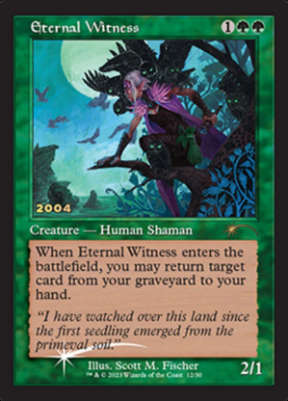
The iconic Eternal Witness was first printed in 2004’s Fifth Dawn. Fifth Dawn takes us away from Dominaria and onto the plane of Argentum, better known as Mirrodin. Argentum was created by Karn and was left under the supervision of one of his creations, a Golem named Memnarch, while Karn explored the Multiverse after becoming a Planeswalker.
When Memnarch gets into the Phyrexian Oil that Karn has stored on the plain he becomes corrupted. In this contaminated state, he is obsessed with becoming a Planeswalker like his creator. It is now that he transforms Argentum into Mirrodin, which has been described as a giant greenhouse designed to produce and nurture life forms that could possess sparks for Memnarch to steal.
Eternal Witness is the first promo so far to be featured heavily in the top decks the year of its release. It has also continued to see play in several formats since then. It’s heavily played in Commander, where it is part of a lot of combos. A combo I like to run with it is Eternal Witness, Phyrexian Altar, and Kaya’s Ghostform.
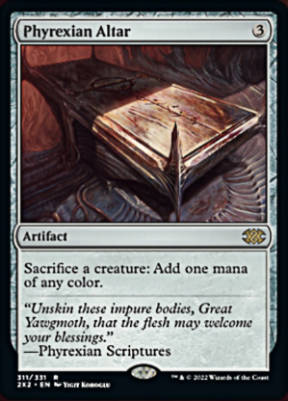
With all three cards, you can cast Kaya’s Ghostform targeting Eternal Witness. Then sacrifice Eternal Witness to Phyrexian Altar. When you do, Eternal Witness returns to the battlefield thanks to Kaya’s Ghostform and you can use the mana from Phyrexian Altar to recast Kaya’s Ghostform. This can be repeated over and over and is just one example of how Eternal Witness can be used.
I suspect this will be the most coveted of these promos. I expect it to turn up quite a bit in flashy EDH decks.
Best Decks Of The Year
Continuing with our theme from the Phyrexia: All will be One Promos, let’s take a look at what the game of MTG looked like back in 2004. Let’s look at some of the very top decks from that year of MTG’s past. That is, after all, the point of having a promo for each year. So, here are the top eight decks of 04.
- Two were Astral Slide deck playing Akroma’s Vengeance, Decree of Justice, and Renewed Faith. Alongside, Wrath of God and a full playset of Eternal Witness.
- Four were artifact-based decks featuring cards like Arcbound Ravager, Arcbound Worker, Cranial Plating, and Frogmite. With many playing Thoughtcast and Mox Amber.
- One mono-red Goblin deck playing Sparksmith, Goblin Piledriver, Goblin Warchief, Clickslither and Electrostatic Bolt.
- One blue/white control deck running Wrath of God, Exalted Angel, Eternal Dragon and counter spells like Annul.
If you’re interested in seeing the full lists for each of these decks, you can find them here.
Chord of Calling
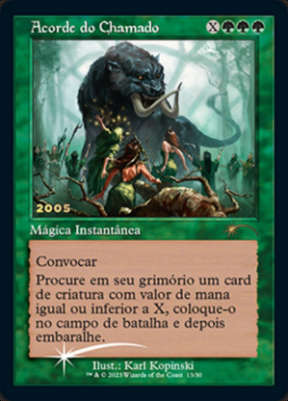
Chord of Calling was first printed in Ravnica: City of Guilds in 2005. It was a cornerstone of a few Modern creature-based combo decks like Elves and “Kikki Chord.” It saw an uptick in play in such decks after the banking of Birthing Pod from Modern. Furthermore, Chord sees quite a bit of play in go-wide strategies in Commander.
Having said that, there will be quite a lot of Elves players that are going to love getting their hands on the March of the Machines promo version of this iconic card. As mentioned, the card was originally printed in 2005 in Ravnica: City of Guilds. So, let’s take a look at the set and that year in MTG’s history.
Starting with Ravnica, the set introduced hybrid mana symbols. It was also the first time that four of the ten dual-colored guilds would make an appearance. Ravnica was also unique from a storyline perspective. The city of Ravnica itself covers the entire plane on which it exists and is home to 10 (one for each of the two color combinations in MTG) guilds.
Until the signing of the Guildpact, the 10 guilds fought for political control of the city. With the signing, came about 1000 years of relative peace. That however comes to an end as tensions escalate once again and this conflict was at the heart of the next few sets.
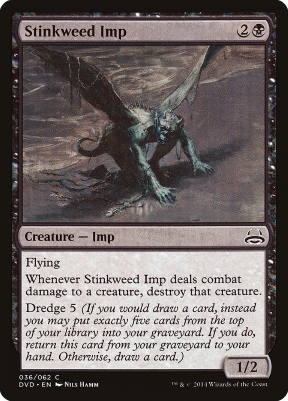
The set is also noteworthy for being the set in which the “Shock Lands” was first printed. Additionally, the very powerful “Dredge” mechanic and many of its best cards come from the set. Here is a list of some of the best cards:
Related: MTG Dual Lands: All Your Questions Answered
- Hallowed Fountain
- Watery Grave
- Blood Crypt
- Stomping Ground
- Temple Garden
- Godless Shrine
- Steam Vents
- Overgrown Tomb
- Sacred Foundry
- Breeding Pool
- Dark Confidant
- Life from the Loam
- Golgari Grave-troll
- Stinkweed Imp
- Golgari Thug
- Chord of Calling
- Lightning Helix
Best Decks Of The Year
Most of the decks from 2005 were playing some number of Umezawa’s Jitte and Pithing Needle. And playsets of Meloku the Clouded Mirror showed up in several decks as well. Below you’ll find a rundown of each deck, but if you want a full list for each deck you can find it here. The top eight decks of the year were as follows:
- Three were green/white decks ramping into Kodama of the North Tree, Arashi, the Sky Asunder, and Arashi, the Sky Asunder. While using tokens and Glare of Subdual to tap opposing creatures.
- One green/black/white deck using the power “dies triggers” of Yosei, the Morning Star and Kokusho, the Evening Star alongside Greater Good and Wrath of God. While recurring the creatures with Goryo’s Vengeance and Reclaim.
- A lone blue/green midrange deck playing counter spells, ramp spells, and powerful creatures like Kodama of the North Tree and Keiga, the Tide Star. While the extra lands the deck ramped into were used with the ability of Meloku the Clouded Mirror.
- One blue/black “Ninjutsu” deck playing Ninja of the Deep Hours alongside Hypnotic Specter and Dimir Cutpurse.
- One blue/black Wizard Tribal deck featuring Meloku the Clouded Mirror, Jushi Apprentice, and Azami, Lady of Scrolls.
- A single blue/white/red enchantment-based control deck built around Faith’s Fetters, Confiscate, Form of the Dragon, and Enduring Ideal.
Niv-Mizzet, the Firemind
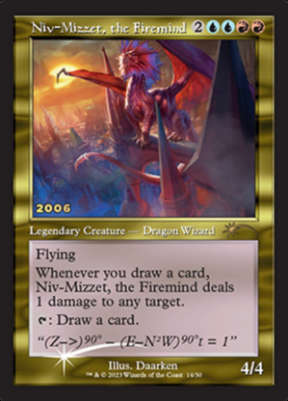
Niv-Mizzet, the Firemind is a beast of a card, that comes from the 2006 set, Guildpact. As mentioned above, the ecumenopolis city of Ravnica has 10 guilds vying for control over it.
About 1000 years before the events of “Guildpact”, the Prauns signed a peace treaty that granted a Millennium of general peace. Niv-Mizzet was one such Praun, behind the signing of the Guildpact. With that said, the time of peace is coming to an end in Ravnica.
Niv-Mizzet, the Firemind is a very powerful card, especially in Commander. There are a plethora of near-infinite game-winning combos that his abilities enable. As a result, he sees quite a bit of play in the 99 of Izzet decks. The combo potential here has nearly limitless variations, so I’ll just show my personal favorite way to combo with him.
With simply a Niv-Mizzet, the Firemind out with a Curiosity attached to him, you get infinite card draw and near-infinite damage. This is just a single combo, and there are tons more. But did Niv see play back in 2006? We’ll let’s take a look at the best decks of that year and find out.
Best Decks Of The Year
Some of the top eight decks from 2006 featured big mana and explosive ramp spells. Let’s take a look at the decks:
- One was a Dragon deck using Rite of Flame and Lotus Bloom to accelerate into Dragonstorm as quickly as possible. Once the deck reached nine mana it could power out several Bogardan Hellkite or Hunted Dragon thanks to Storm on Dragonstorm.
- Four were red, white burn decks – There were some small variations but each one played Rift Bolt, Savannah Lions, Char, and Lightning Helix.
- The remaining three decks were blue/white Tron decks playing Urza’s Mine, Urza’s Powerplant, and Urza’s Tower to ramp into Muse Vessel or Triskelavus looped with [Academy Ruins[/c]. These decks also made great use of Spell Burst to keep opponents off of threats early in the game.
A full deck list for each of the decks above is here.
Buy-A-Box Promo
We don’t know what the buy-a-box promo will be just let. Whenever it is known though, you’ll find it here.
End Step
Players won’t be able to get their hands on the March of the Machines promo cards for quite some time still. However, it’s not too early to peer back in time to what MTG actually looked like in the years these promos are from. Each of the cards comes from a particular year in MTG’s history. After all, that is the entire point of doing promos this way. I hope you find these glimpses into the past via the promo cards as interesting as I do.
